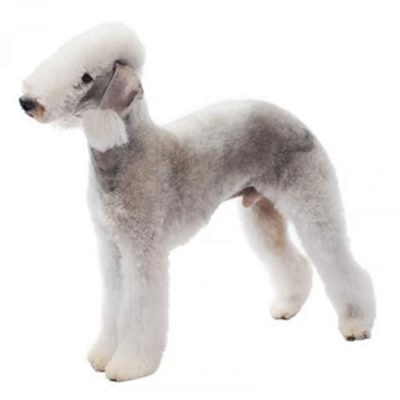Bedlington Terrier
Group 2: Terriers
Height: about 41 cm
Weight: between 8 – 10.5 kg
Energy Level: Medium
Original Function: Hunting
Lifespan: 10 – 14 yrs
Recommended for: Families, elderly, allergy sufferers.

Group 2: Terriers
Height: about 41 cm
Weight: between 8 – 10.5 kg
Energy Level: Medium
Original Function: Hunting
Lifespan: 10 – 14 yrs
Recommended for: Families, elderly, allergy sufferers.

Head of a lamb, heart of a lion!
One of the gamest terriers with a history that goes back so far no one really knows where they originally came from. The first Terrier Clubs formed in the UK were the Dandie Dinmont Club and the Bedlington Terrier Club and they were both formed on the same day.
They take their name from the town of Bedlington in Northumberland where they first became popular with Terrier men. They have also been known as the Rothbury Terrier, the Northumberland Terrier, the Gypsy dog (the Gypsies used them for poaching because they are noiseless killers of vermin and small game) and the Miners dog (they were taken into the mines to eat scraps and kill rats so the mines did not become infested with plague carrying rats). They are one of the few terriers game enough to take on badger.
It was thought they originally came from the border area between England and Wales and could possibly have a relation to the Dandie Dinmont, but no one really knows for sure. They have been used for racing, pit fighting, poaching and competitive rat killing and even today are a formidable foe to a rabbit or mouse and of course are by far the fastest terrier.
They are sensitive, highly intelligent and extremely affectionate. They love children and being hypo allergenic are ideal for asthma and hay fever sufferers. They are easy to house train and excel at dog training. They do bark but usually only with good reason and make good watchdogs.
Appearance: Lamb-like in appearance, long slim head with ears hanging down side of the head. Elegant, graceful on the move with low-set tail.
Temperament: Good tempered, having an affectionate nature, dignified, not shy or nervous. Mild in repose but full of courage when roused.
Characteristics: Spirited and game, full of confidence. An intelligent companion with strong sporting instincts.
Colour: Blue, liver, or sandy with or without tan. Darker pigment to be encouraged. Blues and blue and tans must have black noses; liver and sandies must have brown noses.
Coat: Very distinctive. Thick and linty, standing well out from skin, but not wiry. A distinct tendency to twist, particularly on head and face.
Grooming: Their coat does not moult or shed and does not have a “dog odour”. It needs to be clipped about every 6 weeks and most Bedlington pet owners learn to clip their dogs themselves very well. Of course, you can always take them to a Grooming Parlour. They need to be slicker brushed and combed regularly, eyes cleaned and hair removed from inside ears to allow air to circulate.
Exercise: They will take as much or as little exercise as you care to give them and still stay fit. Exercise does not mean you have to go for long walks, it may mean getting a tennis ball and throwing it for 20 minutes or so.
Bedlington’s also make great “couch potatoes” and love nothing better than to watch the Midday Movie with you. Bedlington’s are quite capable of digging but usually only do this when they are bored. Most would rather lie in the sun. Plenty of toys relieve boredom.
Health: They need a diet consisting of good quality dry food, lean mince and/or cottage cheese. Occasional raw (always) chicken necks or wings are good. They do not tolerate large amounts of fat. The Bedlington terrier used to suffer with copper toxicosis which was genetically inherited.
The Bedlington Terrier Club of New South Wales has had a program to eradicate the disease from the breed and today there is no excuse for anyone to breed a Bedlington Terrier with the disease as there are now plenty of clear males and female available for breeding
Anyone buying a Bedlington should make sure they see either a DNA test for both parents or for the puppy itself showing either 1:2 Carrier or 1:1 Clear.